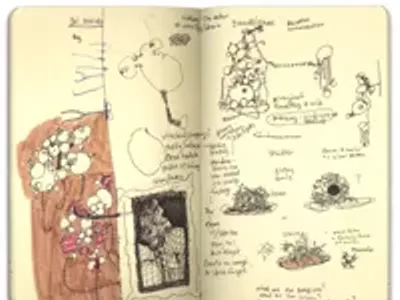
Audio By Carbonatix
[
{
"name": "GPT - Leaderboard - Inline - Content",
"component": "35519556",
"insertPoint": "5th",
"startingPoint": "3",
"requiredCountToDisplay": "3",
"maxInsertions": 100,
"adList": [
{
"adPreset": "LeaderboardInline"
}
]
}
]
Mammies, coons and Uncle Toms shuckin’ and jivin’ are fair material for Betye Saar. The artist doesn’t hold back. She is known for mixing racism with the genteel — juxtaposing stereotypes with cherished images of black life overlooked by society. Her assemblages are also diatribes against racism and sexism that still pervade American popular culture. More than 60 of her provocative works are featured in Betye Saar: Extending the Frozen Moment, at the University of Michigan Museum of Art.
In her mixed-media piece “Black Crows in the White Section Only,” 12 windowpanes show individual images, some of which are advertisements for such items as “darkie” toothpaste and Old Black Joe butter beans. At the bottom are two U.S. flags with Ku Klux Klan hoods.
This retrospective’s title, Frozen Moment, alludes to another significant component of Saar’s work: photography. It’s a medium that has for years promoted ridiculous depictions of black Americans. The artist uses discarded snapshots in an attempt to tell a story, manipulating the photos to imbue them with an aura of mystery and nostalgia. In photographs, she sees things that no longer exist. But she’s also manipulating the work to make it contemporary, and she gives the viewer a chance to glimpse the future. She scours antique shops and second-hand stores for keepsakes to place alongside the pictures. For example, “Midnight Madonnas” shows an old black-and-white photo of a mother holding her baby. In the left-hand corner is a figurine of a black Madonna with baby Jesus.
Saar addresses the subject of skin color in “Colored,” a wooden frame shaped like an arc presenting four photos of women and a child, all of different shades of skin. In the center reads an adage: “Light is Alright, Yellow is Mellow, Brown, Stick Around, Black Get Back.” Below, in parentheses, reads the pithy saying: “but Black doesn’t crack.”
Saar has been considered a formidable modern American artist since the 1960s, with work in collections at museums across the country. Her best-known piece is “The Liberation of Aunt Jemima,” an assemblage from 1972, featuring a kerchief-wearing mammy figure in the foreground against a backdrop of multiple Aunt Jemima screened portraits. The black-faced mammy grins, white teeth glowing, as she grips a broom in one hand and a rifle in the other. Imbedded in the figure’s portly stomach is a framed painting of another mammy holding a white baby.
Born in 1926, Saar grew up in a creative household, attending art receptions and indulging in several hobbies. She says her family lineage includes women who sewed, quilted and made their own clothes. Her mother designed jewelry. As a child Saar made doll clothes. Now, her daughters are artists too. Unsurprisingly, her family figures prominently in her art. There’s a tribute to her great aunt, whose wares take shape in the form of a memory box. But there are also anonymous faces of black people, meant to retool images that appear to come from the Victorian age. These are portraits of black love. In “Miss Ruby Brown,” the photo of Miss Ruby is in a large frame surrounded by her buttons, gloves and other feminine items. The whole work is dipped in crimson paint. The forgotten remnants of coin purses, photos and crosses are relics of everyday lives.
The artist saves her most scathing commentary for the slavery-era interpretations of blacks. “Sambo’s Banjo” converts a minstrel’s instrument case into a container of deprecating racial images. “A Loss of Innocence” is a white christening gown on a hanger; on the garment are the words “tar baby,” “pickaninny,” “coon baby” and “niggerbaby.” And in “I’ll Bend but I Will Not Break,” a slave ship is engraved on a vintage ironing board; clothespins clasp a Ku Klux Klansman’s white sheet behind the board.
Black artists — whether film producers, musicians, poets or artists — often wrestle with the representation of African-Americans in their work. If the mass media perpetuate stereotypes, certainly the natural reaction is to counter it with positive imagery. Saar’s images of black life exude quiet dignity, while confronting stereotypes head-on.
Despite the overtly polemical tone of her work, the artist expresses resignation. She says you just have to turn on the television to see misinterpretations of black people. Her art deals with racial inequities, but it also acknowledges the grave fact that some things may never change.
Through Jan. 8, 2006, at University of Michigan Museum of Art, 525 S. State St., Ann Arbor; 734-764-0395.
Natalie Moore is a freelance arts and culture writer. Send comments to letters@metrotimes.com




